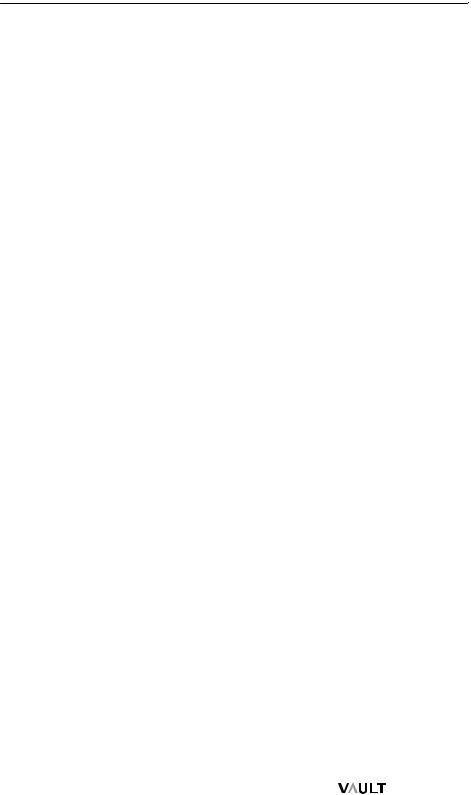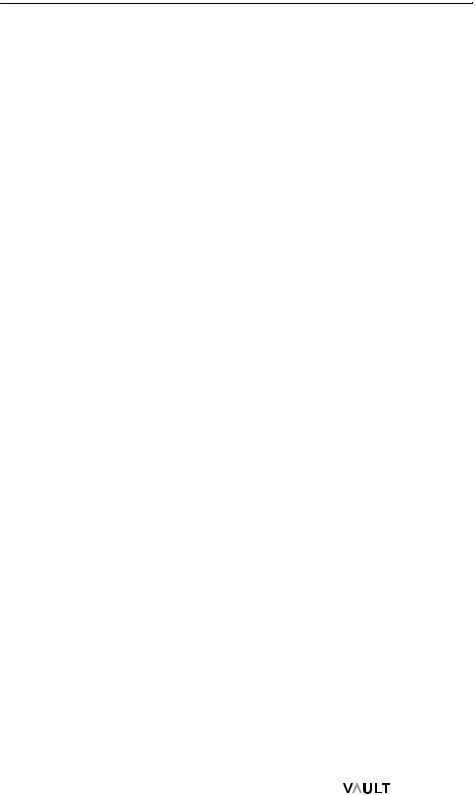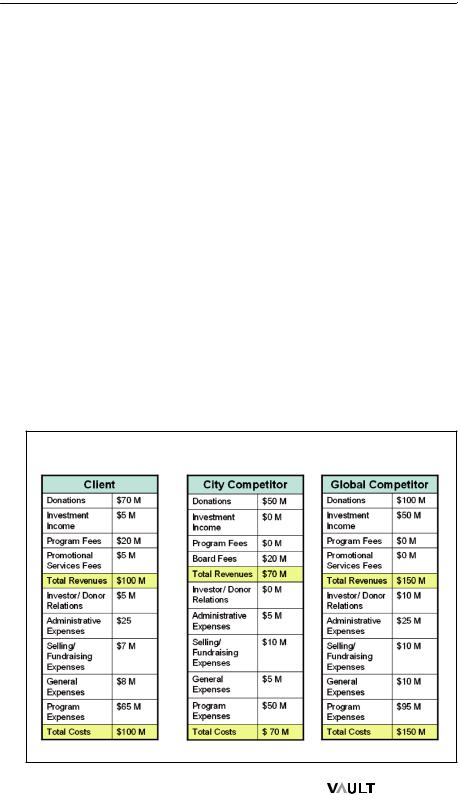
Vault_2-_Cases
.pdf
Vault Case Interview Practice Guide 2: More Case Interviews
Sample Cases
NGO Partnership Case
Your client is a global multinational involved in a one-year-old partnership with an NGO operating in several countries. At the time the agreement was signed, the partnership was defined only at a very high level, and despite best intentions, there has been no progress, leading to frustration on both ends. Both sides have now agreed to try to launch something in a developing country where they both operate.
You have been asked to work with both organizations to understand how this partnership can progress, and whether or not this NGO is even an appropriate partnership for your client. What do you do?
From the beginning, you should realize that you have been described a situation but have been given very little information about either of the two main stakeholders—your client and the NGO. Your first goal should be to understand them.
Interviewee: I would first like to understand the different stakeholders involved. Could you tell me about our client? What businesses does it operate in?
Firm: The client is involved in international ground and air logistics as well as mail services in several countries. Its annual revenue is over $10 billion.
Interviewee: Could you also tell me about the NGO it’s partnered with? What kind of work is it involved in?
Firm: The NGO is also quite large and is involved in various kinds of development work. It runs education programs, grassroots-level development work, and advises developing governments on things like social policy.
(You now know a little bit about the stakeholders involved. If you have some paper you should have noted down those activities. You also want to learn about the partnership. Understanding what it is about may help you later in making an assessment about whether the NGO is an appropriate partner for your client.)
Interviewee: I now understand a little bit about our client and its partner. Could you tell me about the partnership itself?
Firm: What would you like to know?
Interviewee: Why did both groups enter into this partnership to begin with?
Firm: The client wanted to get involved with an NGO for several reasons. A positive image in this area is becoming important because of increasing media
92 |
C A R E E R |
© 2008 Vault.com Inc. |
L I B R A R Y |

Vault Case Interview Practice Guide 2: More Case Interviews
Sample Cases
and consumer attention to CSR—corporate social responsibility. It chose this NGO because of its global reach. Being a global company itself, it was looking for a partnership that could be visible in several different parts of the world. It did not want to just give money to fix a building or paint a classroom; it prefers to use its expertise to do something unique. It wanted a large and stable NGO so that projects could be sustained over a significant period of time and it wasn’t looking for new projects or partners every few months.
As far as the NGO is concerned, it’s always looking for private sector partners to support its work, either financially or in kind. It partners with all kinds and sizes of companies but was attracted in this case for very similar reasons—that is, a successful partnership with a global company could lead to work in different parts its their world.
(You learned a lot of information in that answer. CSR is important to the company not just because it is a good thing to do, but because the company wants to use it to enhance its corporate image—i.e., possible use of any results for marketing purposes. Also, the typical solutions of monetary donations or building a classroom may not appeal because they are not unique. Both parties are interested in taking advantage of each other’s size and trying to launch something that can be duplicated in different parts of the world. This also means the company is going to have to look for similarly large partners if it decides this NGO is not the right one to partner with. By now you have a lot of interesting background information and should start analyzing what should happen going forward. Present a structure for how you plan to work through this analysis.)
Interviewee: I think I understand some of the context of the current situation. I would like to continue, using the following structure. I would first like to see if there are opportunities to develop this partnership, keeping in mind some of the goals of both organizations. If we determine there are no significant opportunities, I would try to evaluate if the client should consider dissolving its partnership with the NGO.
Firm: OK, that’s fine.
Interviewee: Opportunities to develop this partnership can come from our client either becoming involved in the NGO’s ongoing programs or working to develop something new.
Firm: I do not think the client’s first choice would be to piggyback on an existing program. The NGO would also not be averse to something new, but it would need to be very much in line with what it does.
Visit the Vault Consulting Career Channel at www.vault.com/consulting — with insider firm profiles, message boards, the Vault Consulting Job Board and more.
L I B R A R Y |
93 |
C A R E E R |
|

Vault Case Interview Practice Guide 2: More Case Interviews
Sample Cases
(Your interviewer is guiding you to explore opportunities for a new program. Another hint is that the NGO is likely to be more limited than the client on what it is willing to work on. This could help narrow your areas of exploration.)
Interviewee: I would like to focus on the NGO. You mentioned a few areas it works in. Could you be more specific so that I can better understand its work?
Firm: Sure. In education the NGO runs several campaigns, both independently and with the government. These can be about almost anything. In terms of development, it works in rural areas—building classrooms, clinics, transportation and communication networks, etc. Often it involves private sector partners to provide experts to implement the projects. Its work also usually involves the local or state government, either in implementation or to gain the necessary approvals. It also may advise governments on development or social policy but not actually become involved in carrying it out. When they work with governments, it is often because the government has invited them, but on occasion they will proactively develop proposals for consideration as well.
(OK, pause. You had earlier been given a hint that you may need to focus on the activities of the NGO to search for opportunities for cooperation. You have now been given a lot of information about these activities and should see if there is anything that stands out in the context of the client’s core competencies. Part of your work as a consultant will be to sift through vast amounts of information to determine if any of it is useful. Do not hesitate to ask the interviewer for a few minutes to do this kind of analysis.)
Interviewee: That’s a significant amount of information. I’d like to take a minute to review it and see if it suggests avenues to explore further.
Firm: Sure.
(There are several combinations that can be explored here, and in a real project it is quite likely you would explore most of them. However, the one that should stand out is the NGO’s work in transportation networks [given that the client is involved in logistics]. A weaker possibility is the NGO’s work in communication or education—this can be paired with the client’s expertise from its mail business. It is better to identify two or three possibilities rather than just one, in case your interviewer wants to explore different alternatives.)
Interviewee: I feel there may be a few different areas to explore. One that stands out to me is the combination of the NGO’s work in transportation and the client’s expertise in logistics. Another potential area may be in pairing the NGO’s work in communication or education with the client’s mail business. I would like to explore these further.
94 |
C A R E E R |
© 2008 Vault.com Inc. |
L I B R A R Y |

Vault Case Interview Practice Guide 2: More Case Interviews
Sample Cases
Firm: I think that’s reasonable.
Interviewee: I would like to start with the first one. In the country selected, is there any transportation work that the NGO is involved in?
Firm: No, not presently. But it has periodically worked with the government in this area. The country is quite prone to hurricanes, but being a developing nation, often needs international aid to help recover. The NGO has in the past coordinated efforts at international ports in the aftermath of a hurricane. There were still lots of problems, but the NGO helped a lot.
(The interviewer has given you a specific example of the NGO’s work in the country and in an area the client may be able to work in. This is likely a sign that you are on the right track and the interviewer may want you to develop it further. You could suggest this as an initial hypothesis to gauge how the interviewer wants to proceed. If the interviewer responds vaguely, you may need to consider switching tracks)
Interviewee: You mention there being problems despite the NGO’s involvement. There may be an opportunity to explore if anything can be done to improve this. Being in international logistics our client may have expertise in moving large quantities of goods through international ports, though in this case it may be limited to airports. Would you like me to dive deeper into this area or should we explore some of the other potential opportunities?
(The interviewer could go in several different directions at this point.)
Firm: No, let’s stop here. Based on the information you have, what would be your recommendation?
(The interviewer may want to end the interview or move to another part of it. Even if you feel you only scratched the surface, you need to make a recommendation. You should try to supplement your recommendation by proposing what the next steps might be.)
Interviewee: Based on the preliminary information thus far, I would recommend our client explore if there is an opportunity to combine its logistics expertise with the NGO’s transportation-related work. There may be a second opportunity in communication or education. If none of these leads to the development of a suitable program, the client may need to consider looking for a different partner. However, it needs to realize that there may be only a limited number of NGOs capable of working on a global scope as they want to.
Firm: Now, assume you have got this far before you even started working on site. How would you structure your work once you get there?
Visit the Vault Consulting Career Channel at www.vault.com/consulting — with insider firm profiles, message boards, the Vault Consulting Job Board and more.
L I B R A R Y |
95 |
C A R E E R |
|

Vault Case Interview Practice Guide 2: More Case Interviews
Sample Cases
(You need to outline a high-level workplan. If you can tie it into the structure you used during the interview, even better.)
Interviewee: Similar to my previously outlined structure, I see two distinct parts to this project. The first is looking for a way to further the partnership, and the second is to assess if this partnership is creating value for the client. I would work on the first part in a three-phase structure. In the first phase, I would confirm the client and the NGO’s goals for this partnership, understand the NGO’s work in depth, the client’s core competencies based on its lines of business and then look for areas of overlap. In the second phase, I would concentrate on looking for projects the two organizations can work on in these areas. If any are found, the third phase would be assessing their suitability given the resources the client is willing to commit and its business objectives— for example, can the work of the project be duplicated, is the output going to contribute to the corporate image, and so on.
The second part of this project is, I think, our responsibility to the client to evaluate the partnership regardless of whether or not any suitable project is found. I would analyze why there was a lack of progress for so long, use the phase one work to assess future potential for this partnership and review what the other options are for the client. This could take place after the first part of our project or run in parallel as a second workstream.
Firm: I think that’s suitable. Thank you.
Case analysis
This case is about assessing whether there is an opportunity to develop an existing partnership, and whether there is any value in continuing with it, given the business objectives of the client. The interviewer chose not to go into too much depth in analyzing individual options, but directed the discussion toward reaching an initial assessment, and formulated a structure for project planning. The interviewer could have handled this case in several ways. One would be to do a deep dive into a particular option, i.e., analyzing business fit, comparing resource (HR, financial) requirements with what the company was willing to commit, and so on. The interviewer could have also tried to challenge your creativity by asking you to identify several potential options for this partnership. A third option could have been to quickly guide you towards the conclusion that there was little scope for developing this partnership, and then asking you to work through the decision-mak- ing process of whether or not to dissolve it. In the version presented above, the end to the interview may seem a bit abrupt, but this could be an attempt to throw you off or to see how you summarize and close a discussion when you have very limited information.
96 |
C A R E E R |
© 2008 Vault.com Inc. |
L I B R A R Y |

Vault Case Interview Practice Guide 2: More Case Interviews
Sample Cases
Nonprofit Brand Case
Case question/background information provided
The board of a large, U.S.-based nonprofit organization has hired us to help them with a branding problem that the organization is currently having. They received some bad press because of financial mismanagement a few years ago, and while the guilty parties are no longer with the organization, the board feels that the brand is still tarnished—and they’ve also seen a decline in the amount of funds that the organization has raised in the last couple years. They’ve hired us to help turn that around. How would you structure this?
Additional information provided during questioning
•The client organization serves two main functions: 1) it raises millions of dollars through an extensive, countrywide umbrella organization, and 2) it divides up those funds (plus funds that it receives from some investments and from “program membership fees”) amongst grassroots, nonpartisan, nonreligious community organizations serving the poor, children, the elderly and the disabled.
•The client organization has traditionally had a very recognizable brand, and still does. Brand awareness and recall is extraordinary throughout the country.
•(If the interviewee asks) The recent financial mismanagement heavily covered in the press was: the CEO of the organization was caught expensing lavish business trips (staying at the Four Seasons and such), as well as employing family members and paying them incredibly high salaries. This story was covered in national print and broadcast press. He resigned at the time of the story (as did his family members working at the organization), but the board feels that a lot of the damage lingers.
•Because the client is the board of the organization, and not senior management, the role of senior management—even their existence—is definitely in play.
•(A savvy interviewee might ask about the difference between having the board as the client and senior management as the client. If asked, the interviewer should say that it means that senior management’s role/judgment is definitely being questioned and should be considered as part of the potential solution of the case.)
Visit the Vault Consulting Career Channel at www.vault.com/consulting — with insider firm profiles, message boards, the Vault Consulting Job Board and more.
L I B R A R Y |
97 |
C A R E E R |
|

Vault Case Interview Practice Guide 2: More Case Interviews
Sample Cases
It may throw interviewees off, as the client is a nonprofit and not a standard forprofit corporation, which most cases are about. Still, many consulting firms do a significant amount of nonprofit work these days—many also are hired by large nonprofits in the same way they are by for-profits—so, it would not be surprising for a firm to give a case interview with a nonprofit setting. Furthermore, interviewees can apply the same case structuring and analysis techniques in the nonprofit setting that they would in a for-profit case.
That being said, this is a simple branding/revenue problem case. Because it is a marketing case, the four Ps and the three Cs are really the best structure to use to set the case up. Both are shown for the structuring part of the case, but the four Ps are utilized throughout, as they lead in best to the quantitative analysis needed to make a solid recommendation to the client.
Breakdown of solution
Interviewee: So, let me just make sure that I understand the case. The client is a not-for-profit organization, not a for-profit corporation. The board of directors has hired us to help them with their somewhat tarnished brand, and with a decline in donations?
Firm: Well, that’s mostly right. They’ve seen a decline in their funds—which are not necessarily just donations. Let me explain a bit about our client. The client’s organization serves two main functions: 1) it raises millions of dollars through an extensive, countrywide umbrella organization, and 2) it divides up those funds amongst grassroots, nonpartisan, nonreligious community organizations serving the poor, children, the elderly and the disabled. So, it’s seen a decline in the funds that it has to divide up between its member organizations, but those funds come from four sources:
1)Donations from donors
2)Half the interest from the organization’s investments
3)Fees from “membership dues” for the programs sponsored by the client organization
4)Promotional services fees, or fees that it collects from not-for-profits and for-prof- its that want to use the client’s name/brand in its promotional material or products
Interviewee: Ah, interesting. So, the organization’s revenue-generation model is more complicated than just donations from donors. That’s good to know. Before I structure that case, can I get a better understanding of a couple of other things about the client and the case?
98 |
C A R E E R |
© 2008 Vault.com Inc. |
L I B R A R Y |

Vault Case Interview Practice Guide 2: More Case Interviews
Sample Cases
Firm: Sure, go right ahead—ask away.
Interviewee: You mentioned that the client had been in the news lately—and not in a good way. Can I ask what that was about?
Firm: Sure. The recent financial mismanagement that was heavily covered in the press involved the CEO of the organization, who was found to be expensing lavish business trips (staying at the Four Seasons and such), as well as employing family members and paying them incredibly high salaries. This story was covered in national print and broadcast press. He resigned at the time of the story (as did his family members working at the organization), but the board feels that a lot of the damage still lingers.
Interviewee: Do we have a sense of how the client’s brand is viewed?
Firm: Well, we can get further into that in the case, but for now, let’s just say that organization has traditionally had a very recognizable brand, and still does. Brand awareness and recall is extraordinary throughout the country.
Interviewee: I just have one last question: You mentioned that we were hired by the board, not the new CEO. I’ve never worked for a board before—how is that different than working for the CEO of an organization?
Firm: That’s a good question. Because the client is the board of the organization, and not senior management, the role of senior management—even their exis- tence—is definitely in play, and should be considered when developing a solution to the case. So, are you ready to structure how you might approach this problem? Why don’t you take a few minutes to sketch out your thoughts and approach.
(The interviewee’s sketch is illustrated on page 100.)
Interviewee: Well, even though this is a nonprofit client, this still seems like a simple marketing problem to me, so I would use a simple marketing framework to approach the case. First, I would look at our product—the community service organizations that we fund. Maybe we’re not funding the neediest of organizations, and that’s hurting our brand and our revenue. Second, I would look at placement—maybe we’re not in the neediest communities, or countries. Third, I would look at our promotion. I hope that we’ve started promoting our brand differently, or at least stepped up our brand promotion efforts, given the recent bad press that we’ve had. Last, I would look at our price. Now, that’s a tricky one. I’m not sure what the price would be in this situation—maybe it’s the fees that we charge our program members, or the fees we charge for promotional use of our brand, or maybe it’s something with our donors?
Visit the Vault Consulting Career Channel at www.vault.com/consulting — with insider firm profiles, message boards, the Vault Consulting Job Board and more.
L I B R A R Y |
99 |
C A R E E R |
|

Vault Case Interview Practice Guide 2: More Case Interviews
Sample Cases
(A summary of the structure of this approach follows.)
PRODUCT
PRICE
PLACEMENT
PROMOTION
•Has our product changed? Has our product portfolio changed?
•Does the product no longer suit market needs?
•What products are now out in the market?
•How do they compare to ours? Can we create new, customized products that can succeed in the market?
•How is our product (donations, program fees and promotional activities fees) priced?
•Cost plus pricing? Market pricing?
•How does our product’s price compare to that of our competition in the market?
•Can we change our price to succeed in the market?
•Is our product placed in the right markets?
•Are we global, national or local in our placement efforts? Are we in the neediest communities? Best donor markets?
•Are we placed in places accessible to donors?
•Event-based placement?
•Seasonal placement?
•Daily placement?
•How are we marketing our product?
•Has our promotion changed recently? (It probably should have increased, given recent bad press.)
•Have our competitors’ promotional activities changed recently? Has the level of promotional activity in the market changed?
Firm: That’s great. You brought up a couple of interesting things that we discovered. In terms of product, we focus solely on the U.S., not international, which may have made us lose ground to some international nonprofit fundraising organizations.
Interviewee: Wow—so, globalization hits the nonprofit world as well!
Firm: Yes, it does. Second, we looked at our recent promotional spend, and that hadn’t really increased since the bad press.
100 |
C A R E E R |
© 2008 Vault.com Inc. |
L I B R A R Y |

Vault Case Interview Practice Guide 2: More Case Interviews
Sample Cases
Interviewee: That seems a little strange—wouldn’t you want to step up good promotion and press when you’ve just had a bit of bad press?
Firm: Yes, that’s what we thought, too. In all fairness, though, after a few conversations with the CEO, we found out that he froze all budgets because of the bad press. The bad press had to do with financial mismanagement, so he wanted to makes sure that there were no increases in any spending other than spending on the community service programs.
Interviewee: I could see that. It’s probably still hurt the brand a bit.
Firm: Agreed. Now, turning to pricing, you had some interesting thoughts on that. Let’s talk about pricing for a bit, specifically the pricing of donations. What do you think the price of donations is in a not-for-profit like this?
Interviewee: Is it the tiers that donors can give?
(The interviewer will likely let the interviewee guess a bit about this one before showing the exhibit and explaining how pricing works for the nonprofit donor organization client and its competitor.)
Firm: Well, that’s a good guess, but other organizations have tiers, too, and our tiers are in line with the competition. Let me show you some data that we collected where we saw something very interesting.
Exhibit 1: The pricing of donation types
Visit the Vault Consulting Career Channel at www.vault.com/consulting — with insider firm profiles, message boards, the Vault Consulting Job Board and more.
L I B R A R Y |
101 |
C A R E E R |
|
